Sound lab Majestic 545PX by Don Shaulis
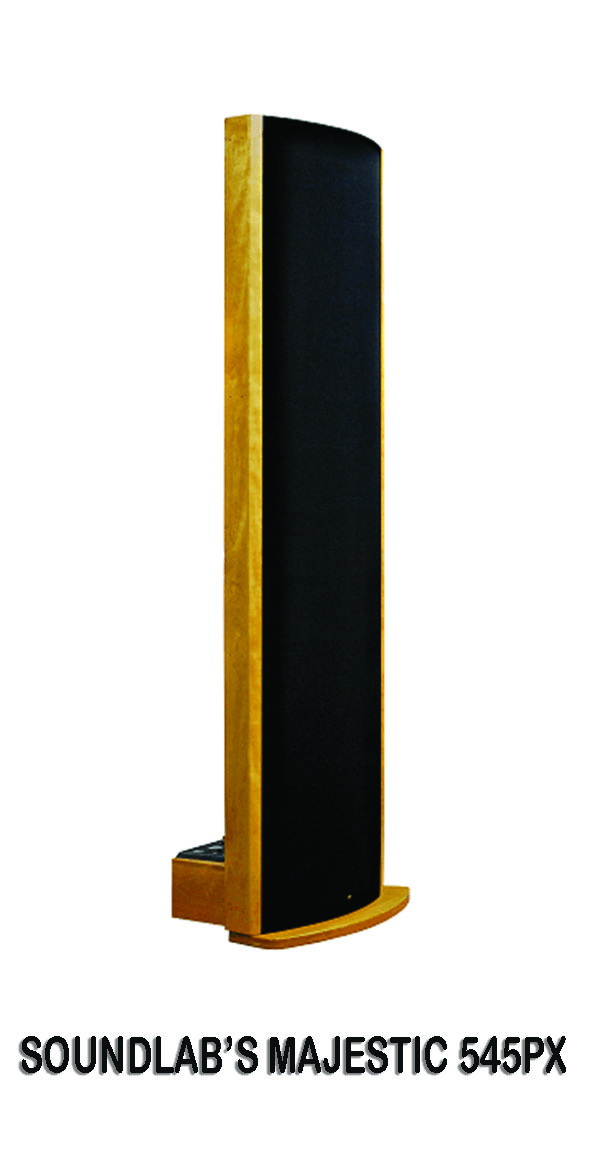
Endgame Loudspeakers
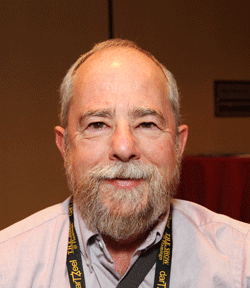 I learned the hard way a long time ago when life hands you lemons – make lemonade. Then sell the lemonade and buy beer. I fell in love with Quad ESL-2805s at first listen at the Consumer Electronics Show (CES) in Las Vegas. I revisited the room several times that year. I eventually bought the beautiful (and rare) classic finish pair used as demos at the Rocky Mountain Audio Fest (RMAF). Like many before me who made earlier model Quads their de facto standard, I made the 2805s my standard for which to measure other speakers. I know Quads have limits, but their strengths spoke louder than their limitations to me. When one speaker suffered bass panel failure, and I suspected the other was close behind, I was saddened and angry. When I found out replacement panels were not available, and if they were, the cost of shipping and repairing would be exorbitant, I was even more angry. Time to make lemonade. Time go bigger and bolder.
I learned the hard way a long time ago when life hands you lemons – make lemonade. Then sell the lemonade and buy beer. I fell in love with Quad ESL-2805s at first listen at the Consumer Electronics Show (CES) in Las Vegas. I revisited the room several times that year. I eventually bought the beautiful (and rare) classic finish pair used as demos at the Rocky Mountain Audio Fest (RMAF). Like many before me who made earlier model Quads their de facto standard, I made the 2805s my standard for which to measure other speakers. I know Quads have limits, but their strengths spoke louder than their limitations to me. When one speaker suffered bass panel failure, and I suspected the other was close behind, I was saddened and angry. When I found out replacement panels were not available, and if they were, the cost of shipping and repairing would be exorbitant, I was even more angry. Time to make lemonade. Time go bigger and bolder.
But where? Immediately before Quads, I owned Apogee Mini Grands (which are Apogee Stage panels mounted on dedicated subwoofers). I was now firmly in the open-baffle; larger drivers are better camp. I had heard all the major electrostatic and planer magnetic speakers brands except Sound Lab, and all had left me not entirely convinced, at least under show conditions. Curiosity piqued and driven by necessity; I began reading about Sound Labs. There were many attributes that called to me. A single panel promised cohesiveness at least equal to Quads. The Majestic 545PX size was slightly larger than my Quads but still not imposing. While I liked the way Quads layered music into the room, I frequently wished the presentation was scaled larger, more majestic. Was the model name of the Sound Lab I was considering a subtle hint? The single panel design avoiding crossovers and multiple drivers with different sonic characteristics, speeds, and dispersion patterns captured my interest. Here was an opportunity to go bigger, but was it bolder?
The Sound Lab website has the best technical information I have seen online. I borrow unabashedly from it here but only briefly. Readers are directed to the website for a full measure of easy to understand design theory. Do not miss the excellent white paper. The information presented on the website was a major factor in my decision to try the Majestic 545PX (545s) speakers.
Please understand my philosophy for reviewing loudspeakers. Appreciate the magnificent futility of trying to micro-analyze speakers for precise tonality of things like brass instruments when changing one item upstream can change the results. This is especially true of Sound Labs with their built-in fine-tuning options (more later). Speakers are the transducers at the end of a long line of electronics and wires and therefore at their mercy and the room they are placed in. I prefer to focus on the main characteristics of the speaker.
Yes, I/we “analyze” changes made by equipment swapping or speaker placement, but in the end, music is not meant to be dissected. It is meant to be enjoyed in its totality. Music is meant to stick in our brain and go into repeat mode when trying to sleep. It is meant to relax us or energize us. Music is emotional, and eventually, hopefully, we sit back and let the music transport us. Or maybe we jump up with joy and grab our favorite air guitar. That works too. Emotion, not analysis, is what brought me back to the Quad room several times at CES years ago. Emotion, not analysis, is why I bought the demo pair of Quads from RMAF and why I began exploring Sound Lab models after the Quads failed.
 At first blush, the Sound Lab site can be a confusing list of model names with the same numbers attached. Sound Labs come in three tiers, Majestic, Audiophile, and Ultimate. The first digit of the model designation refers to the approximate speaker height (5′, 6′, 7′, 8′, and 9′). The second two digits refer to the horizontal dispersion angle (45 and 90-degree models are available). For example, the Majestic 545PX has a height of approximately 5′ and has 45-degree horizontal dispersion. The PX (professional extension) designation refers to major panel technology upgrades Sound Lab introduced in 2006 to compete in the commercial sound market. According to the Sound Lab website, the achieved goals made the speakers’ sensitivity, output capability, physical ruggedness, and reliability competitive with conventional commercial speakers.
At first blush, the Sound Lab site can be a confusing list of model names with the same numbers attached. Sound Labs come in three tiers, Majestic, Audiophile, and Ultimate. The first digit of the model designation refers to the approximate speaker height (5′, 6′, 7′, 8′, and 9′). The second two digits refer to the horizontal dispersion angle (45 and 90-degree models are available). For example, the Majestic 545PX has a height of approximately 5′ and has 45-degree horizontal dispersion. The PX (professional extension) designation refers to major panel technology upgrades Sound Lab introduced in 2006 to compete in the commercial sound market. According to the Sound Lab website, the achieved goals made the speakers’ sensitivity, output capability, physical ruggedness, and reliability competitive with conventional commercial speakers.
PX technology is also incorporated into Sound Labs’ residential speaker line. Sound Lab eventually decided the PX suffix was too cumbersome, so it is not always mentioned on the website but knows that all new Sound Labs in each series incorporate the PX technology. Again, readers are referred to the Sound Labs website and white paper for details. The electronics are identical over all the models and are completely interchangeable from the smallest model to the largest. The only thing that differs is the model identification number on the top plate.
Sound Labs use a single membrane constructed of 100-millionths of an inch thick polyester polymer covered by a very thin, uniform, electrically-conductive film. The film is then protected with a micro-coating of Teflon to seal out moisture and other contaminants. To get a single membrane to reproduce a wide frequency range with accuracy, Sound Labs uses a patented principle labeled “Distributed Resonance.” A grid constructed of wood separates the panel into a series of radiating sectors, each differing in size and resonance frequency. This creates multiple small resonances instead of one major resonance. The collective effect of all resonant sectors solves two problems, membrane drum-head resonance, and dipole energy cancellation.
All full-range Sound Labs include “Bass-Focus” technology employing the grid spacing mentioned above. Grids are spaced such that if someone were to draw a horizontal line across the middle of a speaker, the top and bottom halves would be mirror images of each other. In other words, bass frequencies are reproduced at the very bottom and very top of the panel. It is a D’Appolito array carried further than merely MTM. The consequence of this is to reduce the vertical dispersion of lower frequency energy (i.e., higher directivity), thus increasing energy density and bass dynamics and presenting a larger and more powerful soundstage compared to typical box speakers with bass drivers only located at the bottom.
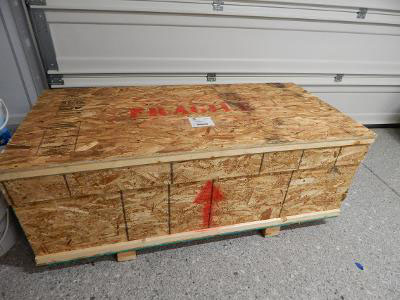
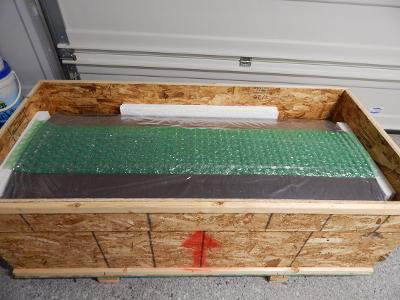
Some Assembly Required
Patience grasshopper. The wait has been long, and the anticipation is building, but there is work to be done, and four hands are needed. The 545s arrived in three boxes. One sturdy wood crate containing two panels and two cardboard boxes containing a base and electronic plate. The plates are installed in the bases for safe shipping but must be temporarily removed to attach the bases to the panels.
With a panel laying face down on something soft, it is easy to attach to its base with four bolts. I left the plastic wrapping on the panel body to keep the dark grill fabric from attracting lint from my carpet. After carefully standing up a speaker by only handling the wood trim, the speaker will be unstable until the electronic plates are reinserted. The plates are heavy, so the hardest part of the assembly is holding them in a partially inserted position. In contrast, three color-coded speaker leads of the wire bundle are inserted into their color-matched receptacles into the mixer module on the electronic plate.
While assembly was reasonably simple, unboxing was much more time-consuming. Everything was heavily wrapped in clear plastic and bubble wrap with foam peanuts filling any void in the boxes containing the bases. The wood crate was easy to open. What to do with the crate after emptying it is another matter altogether. It approached my and my helper’s limit to lift into overhead garage storage. As we get older, I doubt we will be able to retrieve it. Copious amounts of glue prevented the crate from being converted to a flat pack. I remembered the carpenter’s mantra, screws for strength and glue for rigidity. The crate was definitely built to take almost any shipping abuse.
Setup
The owner’s manual gives detailed information on the recommended setup. Five glider feet (1/4″ x 20 threads) are supplied for each speaker. They can provide some tilt adjustment if necessary. Tilting is only recommended if the listener’s ears are above the height of the speakers while listening to them. In that case the amount of tilt recommended is just enough that an imaginary line from the ear to the front of the speaker should be perpendicular to the front surface of the speaker. There is already a slight tilt built into the speakers unless the rear gliders are adjusted to accommodate the difference created by the front “foot,” which is 3/4″ lower than the box containing the electronics. I replaced the gliders with spikes long enough to penetrate my carpet and padding and contact the cement floor underneath and noticed an immediate improvement in bass and midrange performance.
Recommended initial placement is 8 to 10 feet apart on centers and 2′ from the wall behind them. My room is 12′ x 15′ x 9′. Fortunately, an 11’x8′ opening centered on one 15′ wall makes the room seem much larger and not at all confining. An initial towing of 10 degrees is suggested. It is further suggested to increase the toe-in as the distance c/c decreases. I placed four 24 “x48” absorption panels on the wall behind the speakers and another on the sidewall between a speaker and my equipment rack. The other side is mostly open.
 One need not worry too much about the distance to sidewalls. Roger West reminded me, “it is not only acceptable to place the speakers near to a side wall, but it provides a benefit since the wall acts as a partial baffle that reduces the interaction between the front and rear energy fields at lower frequencies. Further, the speakers have a figure-eight dispersion pattern, thus placing them near a wall does not increase wall reflections.” I previously promised more on Sound Labs fine-tuning options. How can absolute tonal fidelity be guaranteed with so many variables from the recording, playback electronics, cables, tube choices, and room? It can’t so relax and enjoy the music already without over-analyzing every note. Sound Labs provide four adjustments that must be made to maximize performance. This can be a blessing or a curse depending on your OCD level.
One need not worry too much about the distance to sidewalls. Roger West reminded me, “it is not only acceptable to place the speakers near to a side wall, but it provides a benefit since the wall acts as a partial baffle that reduces the interaction between the front and rear energy fields at lower frequencies. Further, the speakers have a figure-eight dispersion pattern, thus placing them near a wall does not increase wall reflections.” I previously promised more on Sound Labs fine-tuning options. How can absolute tonal fidelity be guaranteed with so many variables from the recording, playback electronics, cables, tube choices, and room? It can’t so relax and enjoy the music already without over-analyzing every note. Sound Labs provide four adjustments that must be made to maximize performance. This can be a blessing or a curse depending on your OCD level.
First, the bias must be adjusted until a faint crackling sound is heard, then the level backed off until the crackling just disappears. The bias power supply is a mere 2 watts. Then the three equalization controls located on the back-plate for low, middle, and high frequencies can be adjusted to suit the room and personal taste. The “Brilliance” control affects the high-frequency response. It is continuously variable between its minimum and maximum settings. The mid-frequency control alters the frequency response centered around 500 Hz. The mid-frequency and low-frequency controls have discrete settings at +3, 0, -3, and -6dB.
The setup of the 545s was the most difficult I have experienced. Initially, I thought I had made a horrible mistake. But time and perseverance provided great rewards. After finding what I felt was the best position in my room, I was very happy with the results but could not help but feel more was possible. There was that teasing, niggling feeling that I was just missing the 545’s full potential. Sometimes change is hard but necessary. My new home presented an option my old home did not, so I reluctantly took the plunge and moved my rack from between my speakers for the first time. I left my sources on the rack but put my VAC and Boulder integrated amplifiers between the speakers on walnut butcher block stands topped with Symposium platforms. Putting the rack on a side wall necessitated long interconnects, which gave me unnecessary apprehension. In the end, 6.5M Cardas Clear XLR interconnects and Cardas Clear speaker cable laughed at my silliness. They are outstanding cables, and I am thrilled with both the cables and the equipment repositioning results.
Eye of the Beholder
While medium oak is the standard finish, Sound Labs offers other options and custom work. Roger West kindly sent me grill cloth samples and a walnut sample available for my speakers. There was no way I could match the wild color variation in my Claro (California) walnut audio rack. It ranges from almost black to quite red. I experimented with wood stains until I found a combination that I thought went well with my rack and one of the grill cloth samples. Roger was accommodating in having my speaker wood stained to my specifications and finished with the same Osmo PolyxR-Oil I used on my rack. This in lieu of the standard lacquer finish. Having aesthetically pleasing speakers is essential when speakers are this large and endgame. Photographing them and getting the colors correct proved a challenge that could not quite be met. The fabric is a rich dark chocolate with a hint of warmth. Photographing yielded results that were almost black or too red. The photographs do not do the speakers justice. I can say everyone who sees them thinks they are beautiful, and they exceeded my expectations. This is a great example of how to incorporate large speakers and have them be an attractive centerpiece instead of an intrusion.
Listening
Large panels have a different presentation than smaller drivers like 8″ bass drivers and 1″ tweeters in a box. Listening to a well set-up pair of large panel speakers for the first time is transformational. Listeners are captivated by the first notes. Fans of large panels know their magic. They also know the difficulties of seamless integration. I think that is what dissuaded me from

all I heard except for Quads. None of the speakers I heard were completely convincing. Some made the music ethereal (light and airy). Initially interesting but ultimately false. Whatever the speaker’s faults, I just knew I was not drawn in. Listening to the 545s is so completely seamless it reveals the flaws in other speakers I have heard.
Dynamics and spaciousness are important in a speaker and a forte of large panels, but intimacy is also important. Many speaker builders have done a good job creating what appears to be a seamless integration of different drivers. I say appears because, as good as some of those speakers are, a single-driver design shows their slight failings. I was captivated by Imelda May’s breathy plea in “Call Me” from her CD Life, Love, Flesh, Blood [2017 Decca B0026388-02]. In another track, “How Bad Can a Good Girl Be,” she hints at a good reason to call her. Perhaps it was only a rhetorical question, but it left me wondering. The 545’s presentation was perfectly smooth and seductive, conveying the subtle nuances in her hopeful vulnerability. These two songs have been in frequent rotation in my head, and hopefully, entering them here will exorcise them.
 I never fully appreciated the double album The Wall [Mobile Fidelity Sound Lab – UDCD 2-537, Columbia – UDCD 2-537 gold CD reissue] from Pink Floyd until I heard it on the 545s. While I consider some tracks on the double album genius, I find other tracks abrasive noise, and I skip them. They don’t fare better on the 545s. I did experience my favorite tracks in a way I had not previously, and I achieved a new level of enjoyment. The presentation was dynamic, holographic, and also delicate when needed. The soundstage was much expanded vertically from what I experienced with box speakers. The track “Another Brick in the Wall, Pt. 1” starts out dynamic and holographic with a lot of interplay between the left and right channels. The back half of the track is more delicate but equally holographic. The speakers disappear and layer music into the room in three dimensions. Guitar and bass notes have an extended decay. The 545s provided the bigger, bolder presentation I had wished for many times listening to my Quads. This is how the double album was meant to be heard.
I never fully appreciated the double album The Wall [Mobile Fidelity Sound Lab – UDCD 2-537, Columbia – UDCD 2-537 gold CD reissue] from Pink Floyd until I heard it on the 545s. While I consider some tracks on the double album genius, I find other tracks abrasive noise, and I skip them. They don’t fare better on the 545s. I did experience my favorite tracks in a way I had not previously, and I achieved a new level of enjoyment. The presentation was dynamic, holographic, and also delicate when needed. The soundstage was much expanded vertically from what I experienced with box speakers. The track “Another Brick in the Wall, Pt. 1” starts out dynamic and holographic with a lot of interplay between the left and right channels. The back half of the track is more delicate but equally holographic. The speakers disappear and layer music into the room in three dimensions. Guitar and bass notes have an extended decay. The 545s provided the bigger, bolder presentation I had wished for many times listening to my Quads. This is how the double album was meant to be heard.
An area some may criticize is bass response does not go low enough. Bass performance from 545s is articulate and tight. But a rated response of 32Hz leaves much out. This is a problem of most loudspeakers and not unique to the 545s, so it should be taken as an observation more than a criticism. My observation is limited to frequency range, not quantity, since to achieve the proper balance in my room; I only used the 0dB and lower settings and not the +3dB setting. In fairness, any large speaker with bass output at lower frequencies can overload a room since there is no control. This is a good argument for a separate subwoofer with controls. But on a more positive note, the bass quality compared to box resonance bass is obvious. And the reproduction of bass at the top and bottom of the panels gives more impact and a larger scale. This is entirely different from smaller dynamic drivers mounted only a few inches above the floor. I do not have room for subwoofers, so I will learn to love the one I’m with. For my favorite music, the bass response of the 545s is more than adequate, and I appreciate the level of control afforded me. Please note that low-frequency response goes lower, and sensitivity increases as panel size increases.
I feel some electrostatic speakers exaggerate the soundstage and make it too thin. There is a solidity to the 545’s presentation. Spacious and airy but at the same time defined. I attribute this to the symmetrical mirror image driver array. I have experienced similar dispersion with dynamic drivers or dynamic drivers combined with ribbons where at least the midrange and high-frequency drivers are positioned in a tall vertical array, and either one or both of the drivers are open baffle. Another significant benefit of the 545s is their excellent low volume performance. It is not necessary to crank up the volume to help music escape from their boxy confinement. Music is immediately accessible and engaging.
 There is a definite sweet spot when listening to the 545s, and moving to the side loses some magic, as does standing up but to a lesser degree. Perhaps this is a good argument for the wider and taller models. At this point, I should mention a Majestic model not yet listed on the website. It is the same 24″ width as a 545 but approximately 7′ tall. I cannot extrapolate to larger Sound Labs or larger rooms. I can say the 545s were a very good size for my room. They achieved a larger scale presentation while maintaining intimacy where required. The lightness and speed of the diaphragm created fast and sharp attacks with extended and nuanced decays. They brought new enjoyment to parts of my music collection. But there is a flip side to their excellence. They do not favor poor recordings. Compressed and harsh recordings do not fare well. While the 545s have increased my enjoyment of my favorite tracks, they have simultaneously reduced my acceptable playlist. Great speakers deserve equally great recordings and associated equipment. Because of their speed, the 545s require amplifiers with good control and good dynamics but not overly aggressive. Otherwise, very dynamic hits in music can become exaggerated and throw off balance in the presentation.
There is a definite sweet spot when listening to the 545s, and moving to the side loses some magic, as does standing up but to a lesser degree. Perhaps this is a good argument for the wider and taller models. At this point, I should mention a Majestic model not yet listed on the website. It is the same 24″ width as a 545 but approximately 7′ tall. I cannot extrapolate to larger Sound Labs or larger rooms. I can say the 545s were a very good size for my room. They achieved a larger scale presentation while maintaining intimacy where required. The lightness and speed of the diaphragm created fast and sharp attacks with extended and nuanced decays. They brought new enjoyment to parts of my music collection. But there is a flip side to their excellence. They do not favor poor recordings. Compressed and harsh recordings do not fare well. While the 545s have increased my enjoyment of my favorite tracks, they have simultaneously reduced my acceptable playlist. Great speakers deserve equally great recordings and associated equipment. Because of their speed, the 545s require amplifiers with good control and good dynamics but not overly aggressive. Otherwise, very dynamic hits in music can become exaggerated and throw off balance in the presentation.
For amplification, I used two very different integrated amplifiers, a Valve Amplification Company (VAC) Sigma 170i (85wpc) and a Boulder Amplifiers 866 (200wpc). The VAC had more than enough power to be very dynamic, and I barely touched the volume knob. The VAC is not an overly warm integrated amplifier, but it put just the right amount of warmth to voices and instrument harmonics. The Boulder showed off its added power by increasing dynamics and bass impact. I reduced the bass setting compared to the VAC to achieve the balance I liked. Either integrated is an excellent choice for Sound Labs. Both benefit from technology developed for more expensive stablemates from companies that won’t sacrifice performance and build quality just to make a price point. The choice would be entirely up to the listener’s taste and need for optional inputs like phonograph (VAC) or digital (Boulder).
I could go on for a dozen examples of audio tracks that you may or may not be familiar with, but that would miss my point. Repeating what I said previously, music should be enjoyed in its totality, not its minutiae. Emotion is where the power of music lies, and the 545s evoke smiles and appreciation from the first notes.
Conclusion
Although I spent some time here trying to describe the Sound Labs Majestic 545s performance in analytical terms, it is the emotion I get from 545s that makes them so compelling. Larger panels bring a bigger, bolder sound compared to much smaller conventional dynamic drivers inboxes. Live music becomes more “alive” and the soundstage more expansive. But they also provide intimacy when needed for simpler acoustic fare and vocals. The soundstage is expansive when called for but focused.
After heaping praise on the Sound Lab 545PX speakers, I feel compelled to also reveal a downside to purchasing them. Sound Lab is not a large company with a ready inventory. Speakers are custom built as they are ordered, and delivery can take several months. For me, it was worth the wait. They are one of the best speakers I have ever heard. Shortest summary ever: I wish I had owned the Sound Lab Majestic 545s many years ago. They are my endgame speakers for that room.

don shaulis
Specifications:
Price: $15,015 (pair)
Frequency response:32 Hz to ultrasonic
Impedance: 8 ohms (nominal)
Sensitivity: 86 dB/2.83VRMS/1m
Horizontal dispersion: 45 degrees (full spectrum)
Vertical dispersion: Projected field of panel height
Controls: Brilliance, Mid-frequency, Bass level, D.C. Bias
Height x Width x Depth: 56″ x 24″ x 5.5″ (24″ at base)
Weight (per speaker): 97 pounds
Finishes: Medium oak is standard (other finishes are available)
Address:
PO Box 409, Gunnison, UT 84634.
Phone: 435-528-7218
Website: www.soundlabspeakers.com
Email: contact@soundlabspeakers.com
Stereo Times Masthead
Publisher/Founder
Clement Perry
Editor
Dave Thomas
Senior Editors
Frank Alles, Mike Girardi, Russell Lichter, Terry London, Moreno Mitchell, Paul Szabady, Bill Wells, Mike Wright, and Stephen Yan,
Current Contributors
David Abramson, Tim Barrall, Dave Allison, Ron Cook, Lewis Dardick, John Hoffman, Dan Secula, Don Shaulis, Greg Simmons, Eric Teh, Greg Voth, Richard Willie, Ed Van Winkle, Rob Dockery, Richard Doran, and Daveed Turek
Site Management Clement Perry
Ad Designer: Martin Perry



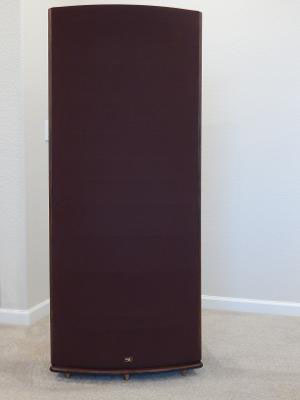
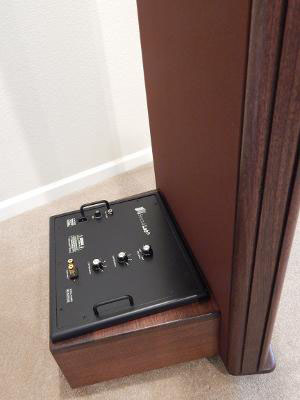
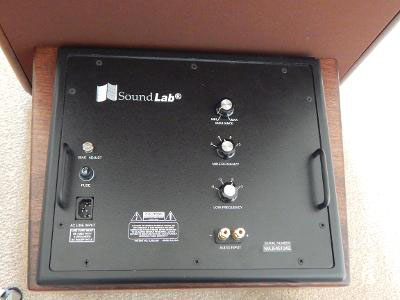





Be the first to comment on: Sound lab Majestic 545PX by Don Shaulis